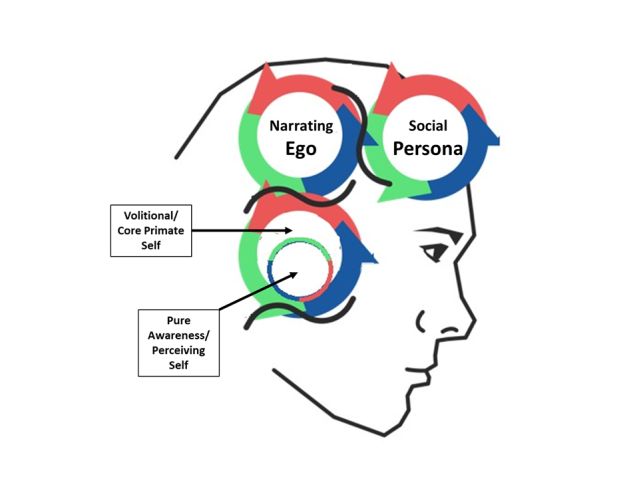Consciousness
The Four Domains of Human Consciousness
Different layers of consciousness can be mapped to better understand humans.
Posted November 8, 2023 Reviewed by Davia Sills
Key points
- Instead of "Who am I?" consider asking "What am I?" and consider these four domains of human consciousness.
- Two domains are shared with other primates and relate to how people perceive and feel about the world.
- Two domains relate to personhood and how people narrate things and navigate the social world.
- Being better educated on the domains of consciousness will help individuals understand themselves better.
What is the best way to map human consciousness? I was recently reading Anil Seth’s excellent book, Being You: A New Science of Consciousness, and I was pleased by the frame he offered. Here, I show how it is aligned with the map of human consciousness given by the Unified Theory of Knowledge (UTOK1).
Before I get into the map, let me say a brief word about the relationship between consciousness and the self. Consciousness refers to the experience of being in the world, whereas the self refers to the domain of awareness that has ownership of that experience and a sense of continuity with it.
Seth divides the domains of consciousness in a way that aligns well with UTOK’s map of human consciousness. Seth’s model starts with what he calls the “bodily self.” This is the most basic layer of the self and refers to the basic differentiation of the human organism from the rest of the world, as well as its placement in the world.
In the language of UTOK, this refers to the “organism-to-animal” layer of organization. It is not so much a domain of consciousness as it is the ground from which subjective conscious experience emerges. With this as a starting point, both UTOK and Seth’s map give us four different domains, two of which exist at what UTOK calls the “minded-primate level” and two of which exist at the “culture-person level” of organization.
We can start with your felt sense of being in the world. The world of sights, sounds, pains, and desires. UTOK calls this layer of human consciousness the “primate experiential self.” UTOK divides the primate experiential self into two broad domains. First, there is the “pure awareness” domain. This refers to the sensory-into-perceptual experience of perceiving things in the world. To see the pure awareness domain clearly, close your eyes and then open them. When you open your eyes, your conscious experience is filled with perceptions of the world around you. This is the domain of the “inner mind’s eye” that is the focus of many meditation traditions.
In addition to perceiving what is in the world, there is a second part of your primate experiential self that has emotions and drives. In other words, it wants things and feels a certain way about the world and what is happening to and around the self. This domain of human consciousness is what UTOK calls the “core self.” It refers to the portion of your experience that has feelings about what you perceive and moves you to approach what you want and avoid what you fear. The relational world is especially important to the core primate self. UTOK maps this with the Influence Matrix.
Seth’s model aligns closely with these two domains. He labels the pure awareness domain the “perspectival self.” He describes it as the portion of consciousness that perceives the environmental landscape and identifies what is relevant. He labels the core self the “volitional self.” He describes it as the portion of your consciousness that makes evaluative judgments and energizes you toward desired outcomes and away from stressors.
UTOK’s map of human consciousness moves from the primate layer into the cultured person layer. Here, too, we find two different domains of human consciousness. In UTOK’s map, the first is the human ego. This is the talking, thinking, and justifying portion of the human mind that (privately) tells the story of what is happening and what ought to happen. The second domain of culture-person consciousness is the persona, which refers to how we think about what other people think of us and work to manage their impressions of us.
Again, Seth’s model, which was derived independently from UTOK, aligns very closely with this map. He calls the ego the “narrative self.” He characterizes it as the portion of the human mind that tells the story of what is going on and gives a sense of continuity and self-conscious ownership of one’s life. He calls the second portion “the social self,” and it is oriented toward what other people think and reflect back, as well as how the person works to navigate the social world.

In sum, although they were developed independently, both Seth’s frame and UTOK’s map give us remarkably similar views on human self-consciousness. Both start at the organism-animal layer of the embodied self as an animal in the world. Then, there is a mammal-primate layer of consciousness that can be effectively divided into (1) perceptions experienced from a point of view and (2) feelings and drives that move the individual toward desired outcomes. Finally, there is the self-conscious (3) narrating ego and (4) social persona that navigates the relational worlds and tries to manage impressions.
So, next time you ask yourself, “Who am I?” perhaps you can start with the question, “What am I?” Answer that by saying you are an organism that occupies a particular body located in a particular place at a particular time. Then note that you are a primate that has a perspective and feels a particular way. Then note that you are a person who justifies things to yourself to make sense of the world and who navigates the social world by considering the perspective of others.
References
1. Henriques, G. (2022). A new synthesis for solving the problem of psychology: Addressing the Enlightenment Gap. Palgrave MacMillan.




